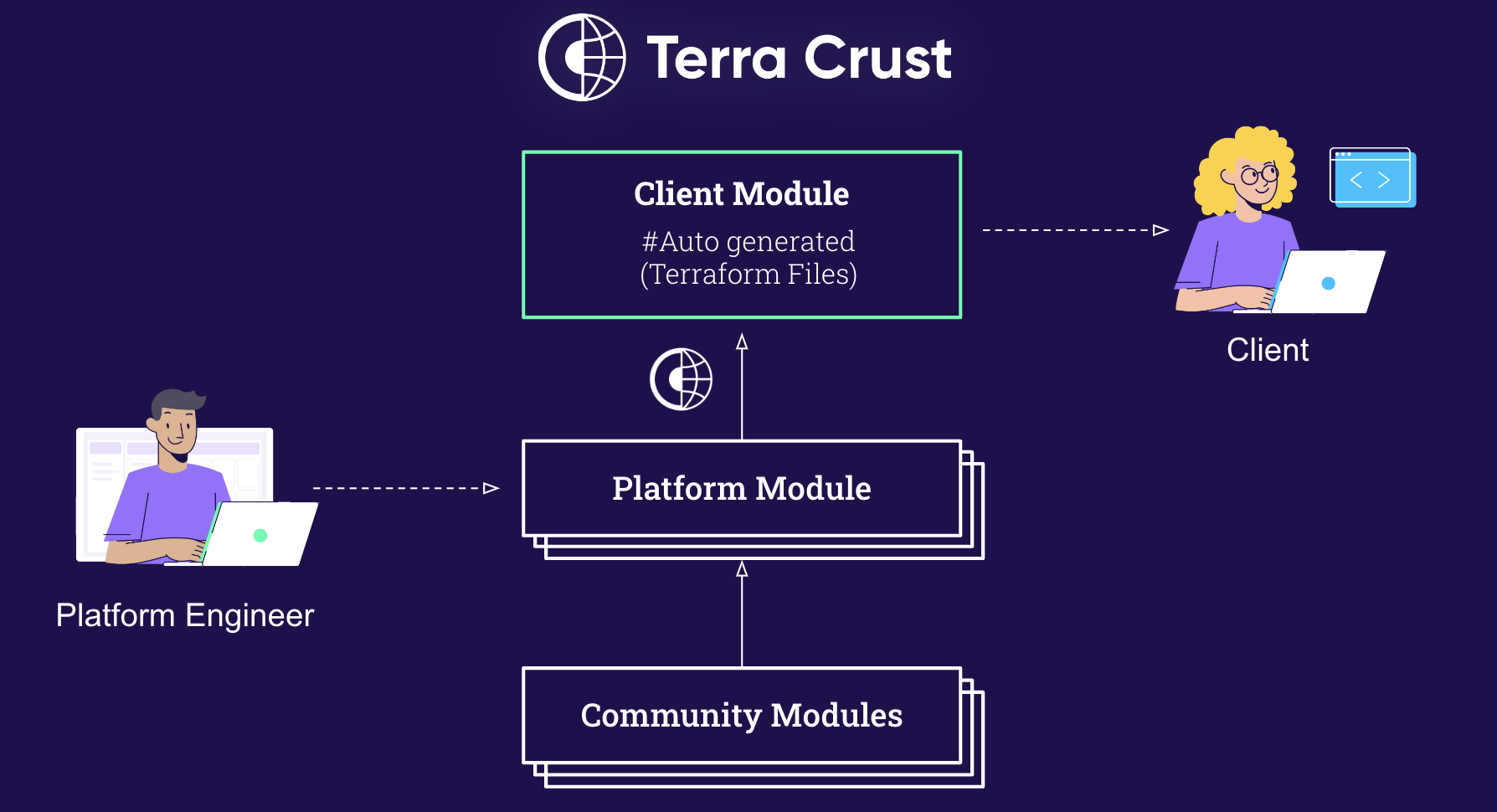Terra crust was created to allow platform teams to expose terraform as the main API communication with the developers, by giving a simple interface in Terraform. Terraform was adopted as our primary language because it is intuitive, declarative, and community driven. We wanted to find a way to have an excellent user experience while increasing the platform productivity, moreover to keep it accessible to use and decrease management overhead. Our goal in developing terra crust was to hide the system's complexity and provide a simple interface to the client based on Facade Pattern and KISS principles.
Listen to a 12 minutes talk about Terra Crust at HashiConf conference Amsterdam June 2022
Check the brakeout session "Running high-throughput, real-time ad platforms in the cloud (ADM302)" at AWS reinvent 2022 presenting Terra crust and the way we empower our developers.
Terra crust creates a root module from existing modules folders inside your terraform project, and exposes all the variables,locals and main used in each module automatically.
It takes the following components and exports it through 3 files, local.tf , variables.tf, main.tf.
- local - module_local.tf exports the locals of each sub module.
- variables - module_variables.tf exports the variables of each sub module.
- main - module_main.tf , exports the required variables as commented values in order to fill in by their logical connection. Optional values are genereated automatically by default, also supports an external main template for development.
Terra crust is going over the module folders and extracting from the Variables.tf files the defaults values for each variable.
Every variable that is Optional must have a default value in it's variable block, even if there is a merge on the locals that already contains the default.
Terra crust will release 3 files that wraps all of the existing modules folder under a general module.
At the end of the flow it will run Terraform FMT to format the files.
terra-crust terraform-main --destination-path="." --source-path=".../modules"
- terra-crust has additional flag:
main-template-pathto support external main templates like in examples/templates/main.tf.tmpl
terra-crust terraform-variables --destination-path="." --source-path=".../modules"
terra-crust terraform-locals --destination-path="." --source-path=".../modules"
terra-crust terraform-all --destination-path="." --source-path=".../modules"
- same as Main has additional flag:
main-template-pathto support external main templates like in examples/templates/main.tf.tmpl - Upon failing on create one of the files , It wont fail the entire flow(Will keep on to the next files).
From version v0.1.0 TerraCrust will support fetching remote modules and composite them into the root module that is being created. From version v0.1.5 TerraCrust will support fetching remote modules with git cli and not only with internal go git client. so save credentials can be used, instead of generating tokens.
in order to activate this feature all you have to do is to set fetch-remote to true like so:
terra-crust terraform-all --main-template-path=./terraform/main.tmpl --destination-path="." --source-path=".../modules" --fetch-remote=trueor with an external git credential with the flag --ext-git to true like so:
terra-crust terraform-all --main-template-path=./terraform/main.tmpl --destination-path="." --source-path=".../modules" --ext-git=trueWhen activating FetchRemote you must use Custom main template, terracrust will look for all sources
that are from git it will look for this pattern:
"git::REPOSITORY.git/PATH/MODULE""git::REPOSITORY"
it will start with git:: then the repository has to end with .git if it has more than 1 module inside it, if the repo is just the root module then no need to add .git to the end. it will also support versioning/ branch reference so feel free to add them , more examples could be found underexamples/templates.
Output Example for this module:
"git::https://github.com/terraform-aws-modules/terraform-aws-iam.git/modules/iam-account"
module "iam-account" {
source = "git::https://github.com/terraform-aws-modules/terraform-aws-iam.git/modules/iam-account"
# account_alias = module. TODO: Add Required Field
hard_expiry = local.iam-account.hard_expiry
require_numbers = local.iam-account.require_numbers
require_symbols = local.iam-account.require_symbols
create_account_password_policy = local.iam-account.create_account_password_policy
allow_users_to_change_password = local.iam-account.allow_users_to_change_password
minimum_password_length = local.iam-account.minimum_password_length
password_reuse_prevention = local.iam-account.password_reuse_prevention
require_lowercase_characters = local.iam-account.require_lowercase_characters
require_uppercase_characters = local.iam-account.require_uppercase_characters
get_caller_identity = local.iam-account.get_caller_identity
max_password_age = local.iam-account.max_password_age
}this will propagate all the default and required variables using the Templates Api
The main.tmpl exposing Template API that includes for now 2 functions:
- GetRequired - Will expose the require variables with option for you to fill
- GetDefaults - Will expose the optional variables - without needing to fill them up
For example:
module "iam-account" {
source = "git::https://github.com/terraform-aws-modules/terraform-aws-iam.git/modules/iam-account"
{{(GetRequired "iam-account" .)}}
{{(GetDefaults "iam-account" .)}}
}Results can be seen at the section above, basically after you fill the required variables,
you want to get rid of {{(GetRequired "iam-account" .)}} because it will keep overwriting your changes
so once you filled the required variables you can drop it instead and put the required variables you filled in the template.
Further guidelines as well as examples, can be shown here.
In order to contribute, please make sure to test and validate that everything is working, including lint ci, open a merge request and wait for approval.






